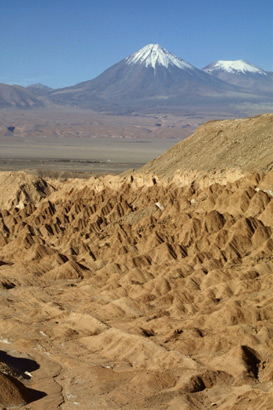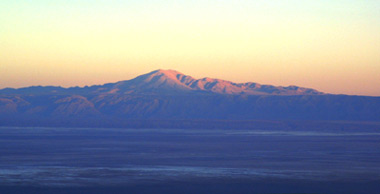




| Volcanoes | |||||||||
Volcanoes are formed from friction produced by currents of liquid hot magma between continental masses, which fracture the Earth´s crust. In Chile´s case, the Nazca oceanic plate penetrates the South American continent. The fused material can be found between 3 and 124
miles (4 and 200 kilometers) below the surface, with temperatures
reaching 1,832 degrees Fahrenheit (1,000 degrees Celsius). Fifteen
hundred active volcanoes have been identified in the world, with
almost 10 percent of these in Chile. San Pedro is located at the base of Licancabur. The
native name of this inactive volcano menas “Village Mountain.”
Licancabur is located 37 miles (60 kilometers) northeast of San
Pedro, at the border between Chile and Bolivia, and rises 19,409
feet (5,916 meters) above sea level. From its summit, climbers can
see a complete panoramic view of the region, including the Atacama
Salt flat. Another inactive volcano, Juriques, rises to 18,864 feet
(5,750 meters) and it is located beside Licancabur. Láscar is one of the major active volcanoes in South America. Its height rises to 18,346 feet (5,592 meters) and is located 74 miles southeast of San Pedro. Lascar’s caldera houses six overlapping craters. The active crater, located near the center of the cluster, is about 2,640 feet (750 meters) wide and 984 feet (300 meters) deep. During its last eruption on July 20, 2000, Lascar shot a huge plume of ash 27 miles (45 kilometers) into the sky. In order to climb the volcano, it is necessary to acclamitize to the altitude and be cautious of the high wind speed, which can reach 124 miles per hour (200 kilometers per hour).
|

